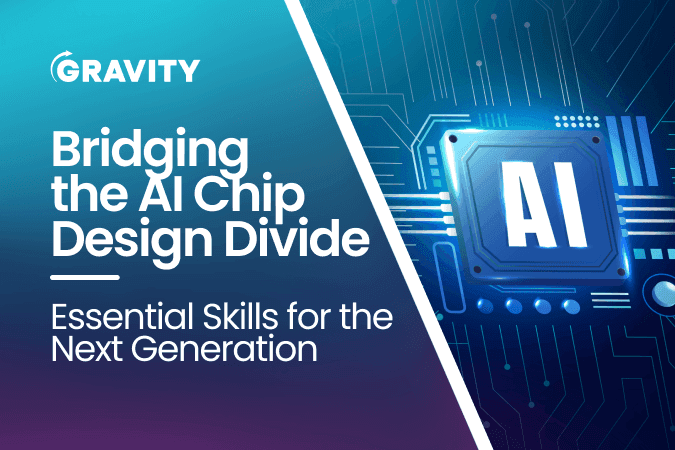The AI chip market is on a meteoric rise, projected to reach $450 billion by 2030, fueled by demand for smarter, faster chips in AI-powered devices, IoT, and edge computing. However, semiconductor companies face a critical hurdle: a widening skills gap. Many hardware teams lack expertise in modern AI methodologies, creating what analysts call a “looming talent cliff.” McKinsey projects shortages of over 100,000 semiconductor workers in both the U.S. and Europe by 2030, with Asia-Pacific needing more than 200,000. A survey reveals that nearly half of business leaders cite a lack of skilled talent as a major barrier to AI projects. To stay competitive, companies must equip their teams with new skills to design AI-optimized chips, aligning workforce capabilities with cutting-edge silicon demands.
The rapid evolution of AI, IoT, and edge computing has outpaced traditional engineering training. Neural networks require chips with unprecedented throughput, massive parallelism, and stringent power constraints—demands unfamiliar to many classic hardware engineers. Meanwhile, AI software experts often lack deep hardware knowledge, creating a disconnect. As industry observers note, software engineers rarely understand hardware intricacies, and hardware engineers struggle with AI software. This is compounded by advanced process technologies (e.g., 3D-stacked memory, analog/mixed-signal IP) requiring integrated system design. The result is a dual shortage: surging demand for AI-optimized chips and a scarcity of engineers skilled in both AI algorithms and chip architecture. Arm’s research highlights that 34% of companies feel significantly under-resourced in AI skills, with only 17% of their workforce possessing advanced AI capabilities.
To close this divide, teams need a blend of AI and hardware expertise. Key skills include:
Machine Learning Fundamentals: Chip designers must understand AI concepts, such as neural networks (CNNs, RNNs, transformers), their accuracy-efficiency trade-offs, and how to map algorithms to hardware constraints. While not data scientists, engineers need enough ML knowledge to design chips that optimize model performance, ensuring efficient computation and power usage.
Hardware-Software Co-Design: AI chips thrive on tight integration between hardware and software. Engineers should be proficient in embedded software (C/C++, Python), hardware description languages (Verilog, VHDL), and AI frameworks (TensorFlow, PyTorch). This enables co-optimization, where software and hardware are tailored for specific applications, using system-level simulation to balance trade-offs. Collaboration is key: software engineers need exposure to RTL, while hardware engineers must understand compiler behaviors.
Accelerator Expertise (GPUs, TPUs, ASICs): AI workloads often rely on specialized accelerators. Engineers must master the trade-offs of GPUs, TPUs, and custom ASICs. For example, ASICs can be 100–1000× more efficient than CPUs, ideal for power-constrained edge devices, but they sacrifice programmability. GPUs and FPGAs offer flexibility but consume more power. Teams need to select or design accelerators (e.g., NPUs, analog ML blocks) that balance performance, power, and cost, while applying techniques like quantization and pruning to fit models on constrained hardware.
System-Level Optimization: AI chip design demands advanced verification and optimization. Engineers must excel in RTL simulation, emulation, static timing analysis, and power/thermal modeling. “Shifting left” by starting verification early ensures chips handle complex AI workloads. FPGA-based emulation and realistic workload testing help identify critical performance windows, while multi-physics skills (digital, analog, thermal) ensure chips meet energy and performance targets.
Dataflow and Parallel Computing: AI workloads require parallel processing expertise. Engineers need skills in pipelining, loop unrolling, memory tiling, and parallel execution to sustain high throughput. Understanding hierarchical memory (caches vs. DRAM) and avoiding bottlenecks like bus contention is critical. Teams must leverage data-level and task-level parallelism to optimize both training and inference across compute units.
AI Frameworks and Model Compression: Designers should be fluent in ML frameworks (TensorFlow, PyTorch) and techniques like quantization, weight sparsification, and knowledge distillation. These methods shape hardware requirements, enabling efficient model deployment on edge devices. Familiarity with compilers (e.g., TVM, Glow) helps map neural networks to accelerators while preserving accuracy.
To cultivate these skills, companies must adopt targeted strategies:
Cross-Training Programs: Offer workshops, hackathons, and certifications to teach hardware engineers AI fundamentals and software engineers hardware basics. Rotation programs, where designers work on AI software teams or vice versa, foster cross-disciplinary understanding. These initiatives build collaboration and practical skills.
Hybrid Talent Recruitment: Hire engineers with dual expertise in computer engineering and data science, or those experienced in open-source AI hardware projects. Job postings should emphasize skills like Python, C++, ML frameworks, and RTL, blending traditional and modern requirements. Surveys show 53% of companies plan to hire new AI talent, while 66% focus on upskilling existing staff.
Industry–Academia Collaboration: Partner with universities to develop AI chip design curricula, sponsor research, and offer internships. For example, Malaysia’s partnership with Arm aims to train 10,000 engineers, while Japan’s AI chip design school targets cutting-edge ML hardware skills. These programs align education with industry needs.
Industry Alliances and Apprenticeships: Engage with groups like the Semiconductor Education Alliance to standardize curricula. Support apprenticeships for technicians and entry-level engineers, with a focus on diversity to expand the talent pool. Government grants for workforce development can amplify these efforts.
Teams equipped with these skills will lead the AI chip market, delivering chips with superior performance and efficiency. For instance, custom ASICs can run edge vision tasks at tens of milliwatts, compared to watts for GPUs, giving a clear advantage in mobile, IoT, and automotive applications. Companies mastering HW/SW co-design can innovate with on-chip learning or federated AI, enabling real-time model updates and low-latency experiences. As one expert notes, tailored architectures optimized for specific applications maximize every joule of energy, ensuring breakthrough performance.
By investing in cross-domain talent and leveraging staffing partners for recruitment and training, companies can close the AI chip design gap. This positions them to deliver faster time-to-market, higher performance-per-watt, and innovative features, securing a leadership role in the AI-driven semiconductor revolution.
